
British Warship Losses in the Modern Era 1920-1982. By David Hepper. Published by Seaforth Publishing, Barnsley, 2022. ISBN 978-1-3990-9766-6.
Reviewed by David Hobbs
BUY FROM BOOKTOPIA NOW
David Hepper served in the RN for twenty-five years during which he specialised in electronic warfare. After leaving the Navy he became a civil servant but maintained his lifelong interest in naval history by carrying out research into ships’ histories at the National Archive.
This is his second book; his first, also published by Seaforth, covered British Warship losses in the age of sail, during the First World War and in subsequent Baltic operations against the Bolsheviks.
The term ‘British’ in this thoroughly-researched reference book includes Commonwealth warships including ships of the RAN, RCN, RNZN and the wartime losses of the then Royal Indian Navy. The losses suffered after independence and partition in 1947 by the navies of India and Pakistan are not included. The author gives a succinct description of the circumstances of each ship’s loss, amplified in many cases by describing the actions in which they were taking part and warship losses up to and including the South Atlantic War of 1982 are included . Hepper has clearly carried out extensive research using primary sources and the result is a comprehensive compilation of warship losses from the largest battleship to the smallest motor launch. Losses are listed in date order and can be located within the text by finding the ship and its date of sinking in the comprehensive twenty-seven page index and then turning to the appropriate date. Losses are divided into four sections, January 1920 to September 1939, September 1939 to August 1945, August 1945 to April 1984 and Minor Landing Craft 1939 to 1945. Although the book’s title refers to losses between 1920 and 1982, the author has in fact included a single RN minor landing craft lost in 1984 for the sake of completeness.
The fates of more than 2,000 warships are described and from an RAN perspective these include all the ships that one would expect to see from the cruisers Canberra, Sydney and Perth, through destroyers such as Nestor and the two Voyagers to sloops such as Yarra and Parramatta together with smaller vessels. Each entry starts with data which gives the type of ship, where it was built, year of launch, dimensions, armament and the name of its commanding officer. At the end of each entry the author gives the sources from which he gathered his information. Many of these come from ADM files at the UK National Archive but RAN ships also have Australian Government sources where these are definitive. Unfortunately there is a minor error in the data listed for HMAS Sydney on page 135 which describes her as having a main armament of eight 8-inch guns, whereas in fact it was eight 6-inch guns. Her torpedo armament is not mentioned. Given that the book contains nearly 400 pages of text and the careful research that the author must have put into compiling it, I consider this to be a minor error and I did not find any others. One of the things that struck me most as I studied the book’s contents was the number of landing craft lost in the various amphibious operations carried out as the allies took the fight to the enemy from 1943. Major landing craft are included in the main index but there is a separate index for minor landing craft that fills seven pages. I was, of course, aware that there had been losses but seeing them laid out in this way brought home their scale. Whilst the majority of entries cover ships that were lost during World War Two, there are significant entries for ships lost after 1945. The losses of the armament stores carrier Woomera in 1960, the destroyer Voyager after a collision with Melbourne in 1964 and the patrol boat Arrow during Cyclone Tracy in 1974 are covered. References to Boards of Enquiry or Royal Commissions of Enquiry are given with the source notes, where appropriate. There are forty well-chosen black and white photographs, many of which show ships in a sinking condition.
The descriptive text for each loss and the brief summaries of the actions in which they were taking part make this book into a significant improvement over earlier works on the subject and it must be considered the definitive reference on Commonwealth warships during the era in question. Notwithstanding that small error, it is an outstanding book which I have already added to my library. I recommend it highly.



